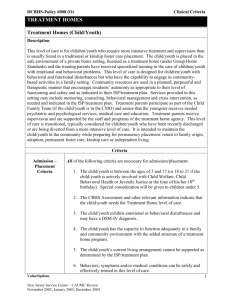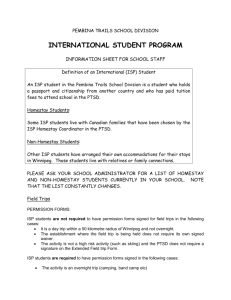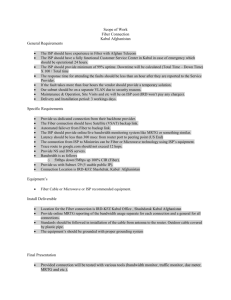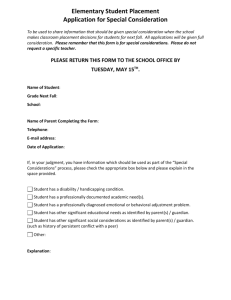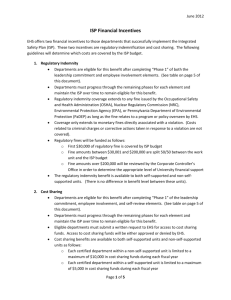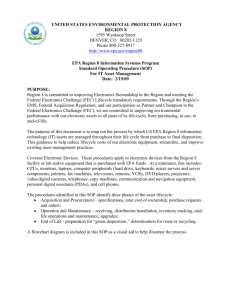5 - CGS Family Partnership
advertisement
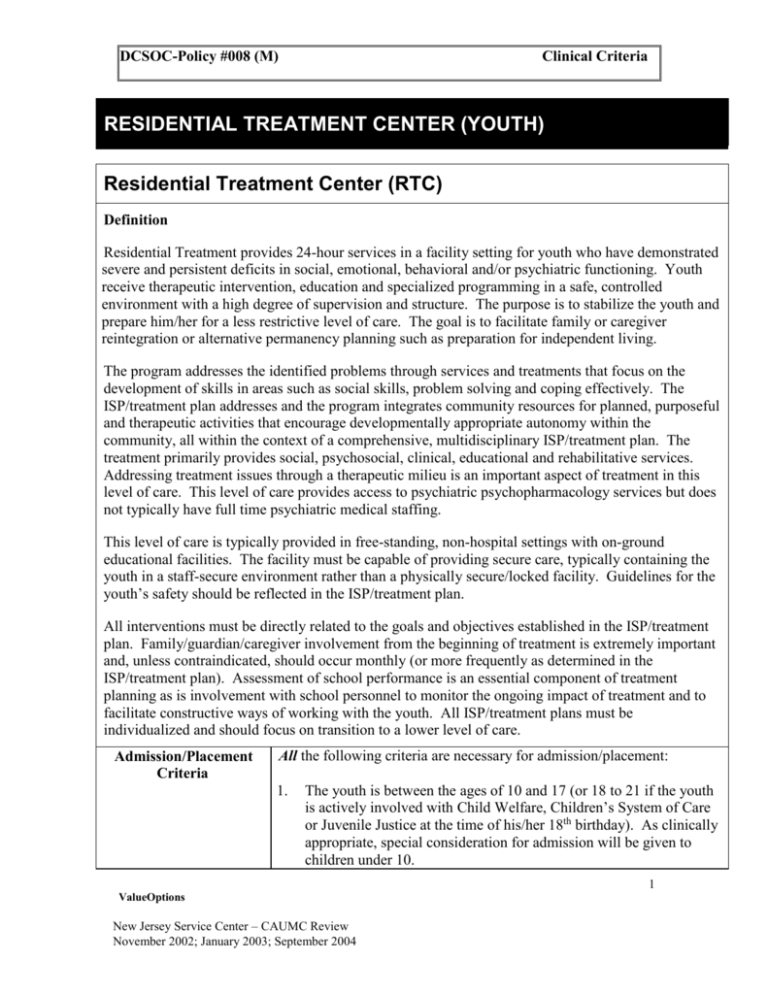
DCSOC-Policy #008 (M) Clinical Criteria RESIDENTIAL TREATMENT CENTER (YOUTH) Residential Treatment Center (RTC) Definition Residential Treatment provides 24-hour services in a facility setting for youth who have demonstrated severe and persistent deficits in social, emotional, behavioral and/or psychiatric functioning. Youth receive therapeutic intervention, education and specialized programming in a safe, controlled environment with a high degree of supervision and structure. The purpose is to stabilize the youth and prepare him/her for a less restrictive level of care. The goal is to facilitate family or caregiver reintegration or alternative permanency planning such as preparation for independent living. The program addresses the identified problems through services and treatments that focus on the development of skills in areas such as social skills, problem solving and coping effectively. The ISP/treatment plan addresses and the program integrates community resources for planned, purposeful and therapeutic activities that encourage developmentally appropriate autonomy within the community, all within the context of a comprehensive, multidisciplinary ISP/treatment plan. The treatment primarily provides social, psychosocial, clinical, educational and rehabilitative services. Addressing treatment issues through a therapeutic milieu is an important aspect of treatment in this level of care. This level of care provides access to psychiatric psychopharmacology services but does not typically have full time psychiatric medical staffing. This level of care is typically provided in free-standing, non-hospital settings with on-ground educational facilities. The facility must be capable of providing secure care, typically containing the youth in a staff-secure environment rather than a physically secure/locked facility. Guidelines for the youth’s safety should be reflected in the ISP/treatment plan. All interventions must be directly related to the goals and objectives established in the ISP/treatment plan. Family/guardian/caregiver involvement from the beginning of treatment is extremely important and, unless contraindicated, should occur monthly (or more frequently as determined in the ISP/treatment plan). Assessment of school performance is an essential component of treatment planning as is involvement with school personnel to monitor the ongoing impact of treatment and to facilitate constructive ways of working with the youth. All ISP/treatment plans must be individualized and should focus on transition to a lower level of care. Admission/Placement Criteria All the following criteria are necessary for admission/placement: 1. The youth is between the ages of 10 and 17 (or 18 to 21 if the youth is actively involved with Child Welfare, Children’s System of Care or Juvenile Justice at the time of his/her 18th birthday). As clinically appropriate, special consideration for admission will be given to children under 10. 1 ValueOptions New Jersey Service Center – CAUMC Review November 2002; January 2003; September 2004 DCSOC-Policy #008 (M) Clinical Criteria 2. The DCSOC Assessment and other relevant information indicate that the youth needs the residential level of care. 3. The youth is in need of 24 hour supervision due to emotional and/or behavioral problems in the home and/or community to such an extent that: a. The psychological or physical safety of the youth or others is at risk; and/or b. The youth has been (or is) at risk of being excluded from normal community, home, or school activities due to significantly disruptive symptoms and/or behaviors. Psychological, Occupational, Cultural and Linguistic Factors Exclusion Criteria 4. The youth exhibits severe maladaptive behaviors (i.e., aggression, depression, harmful to self or others, alcohol or other substance abuse, runaway behavior, etc.) and has a DSM-IV diagnosis. 5. Disturbances/behaviors/symptoms are such that treatment cannot be successfully provided in a lower level of care. 6. The youth demonstrates a capacity to respond favorably to rehabilitative counseling, specialized programming and skill development in a structured milieu. 7. This level of care is the best (or only) option to manage the youth. These factors may change the risk assessment and should be considered when making level of care or placement decisions. Any of the following criteria is sufficient for exclusion from this level of care: 1. The youth’s parent/custodian/guardian does not voluntarily consent to admission or treatment and there is no court order requiring such placement. 2. The youth exhibits behavioral and/or psychiatric symptoms that require a more intensive level of care/setting. 3. The youth is unable to perform skills of daily living and requires custodial care and/or interventions that go beyond the capability of this setting and the individualized wraparound process will not enable the youth to enter this level of care. 2 ValueOptions New Jersey Service Center – CAUMC Review November 2002; January 2003; September 2004 DCSOC-Policy #008 (M) Clinical Criteria 4. The youth has medical conditions or impairments that would prevent participation in services and that require daily care that is beyond the capability of this setting and the individualized wraparound process will not enable the youth to enter this level of care. 5. The DCSOC Assessment and other relevant information indicate that the youth can be safely maintained and effectively treated in a less (or more) intensive level of care. 6. The youth exhibits suicidal, homicidal or acute mood symptoms or a thought disorder that requires a more intensive level of care. Continued Stay Criteria All of the following criteria are necessary for continuing services at this level of care: 1. The DCSOC Assessment and other relevant information indicate that the youth continues to need the residential level of care. 2. The youth’s treatment does not require a more intensive level of care, and no less intensive level of care would be appropriate. 3. The ISP/treatment plan is individualized and appropriate to the youth’s changing condition with realistic and specific goals and objectives clearly stated. 4. Progress in relation to specific symptoms or impairments is clearly evident and can be described in objective terms, but goals of treatment have not been achieved and adjustments in the ISP/treatment plan to address the lack of progress are evident. 5. Care is rendered in a clinically appropriate manner and focused on the youth’s behavioral and functional outcomes as described in the ISP/treatment/discharge plan. 6. All services and treatments are carefully structured to achieve reintegration into the family or community in the most time efficient manner possible consistent with sound clinical practice. 7. When indicated, an appropriate psychopharmacological evaluation has been completed and ongoing treatment is initiated and monitored. 3 ValueOptions New Jersey Service Center – CAUMC Review November 2002; January 2003; September 2004 DCSOC-Policy #008 (M) Clinical Criteria 8. The ISP/treatment plan indicates that the parent (or guardian or custodian) is actively involved in the child’s/youth’s services as required by the ISP/treatment plan. 9. Discharge Criteria There is documentation of active discharge planning. Any of the following criteria is sufficient for discharge from this level of care: 1. The youth no longer meets criteria or meets criteria for a more (or less) intensive level of care. 2. The DCSOC Assessment and other relevant information indicates that the youth needs a more (or less) intensive level of care. 3. The youth exhibits severe disruptive or dangerous behaviors that require immediate attention in a more secure and/or intensive level of care; and efforts to supplement the resources at the facility have failed. 4. The youth’s documented ISP/treatment plan goals and objectives have been substantially met. 5. The youth has been transitioned to a lower level of care (i.e., group home, treatment home, independent living program). 6. The youth has been reunified with his/her parent/caregiver/custodian, transitioned to an alternative permanent placement (i.e.: foster home, kinship care, adoptive home), or transitioned to living independently. 7. The youth is not making progress at this level of care and there is no reasonable expectation of progress at this level of care. An alternative ISP/treatment plan has been developed. 8. Consent for treatment is withdrawn by the parent/custodian/guardian and there is no court order requiring such placement. 4 ValueOptions New Jersey Service Center – CAUMC Review November 2002; January 2003; September 2004

